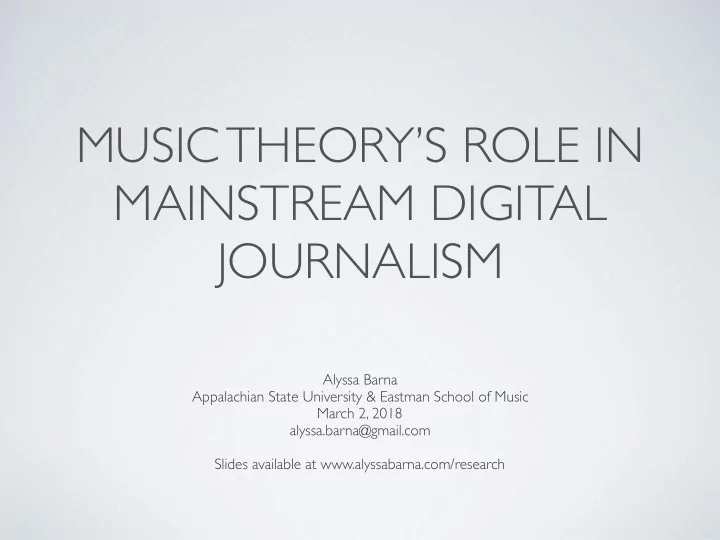

MUSIC THEORY’S ROLE IN MAINSTREAM DIGITAL JOURNALISM Alyssa Barna Appalachian State University & Eastman School of Music March 2, 2018 alyssa.barna@gmail.com Slides available at www.alyssabarna.com/research
OUTLINE OF THE PRESENTATION I. Problems II. Examples III. Journalism IV. The Pitch
PROBLEMS Where have all the theorists gone? Who is writing these articles, then? What even is a music theorist? Give the people what they want.
EXAMPLES “ 8. Displaced Guitar Rhythm in “Let Down” (1997-5, 2:11) In the first chorus the lead guitar plays a three-note melody starting on a high A (A–G#–E). It happens right on beat 1, but in the second chorus, it gets moved back a beat early, beginning on beat 4 of the previous bar. Why? To my ears, the misplaced high A actually foreshadows the song’s climax: Yorke’s heroic ascent to that same high A in the third verse (“one DAY”).” "1. Euclidean rhythms in “Pyramid Song” (2001-2, throughout) Why has more ink been spilled on this rhythm than any other moment in Radiohead’s catalog? Like the Golden Ratio in music, it’s because of a special geometry. The five chords are arranged unevenly over 16 beats as 3+3+4+3+3. It’s longer in the middle than the ends, just like a pyramid, and, just like a pyramid has four sides of 3 angles and one side with 4 angles, this rhythm has four chords lasting 3 beats and one lasting 4 beats. Coincidence? Maybe not: both of these pyramid shapes can be explained through the Euclidean algorithm—a mathematical formulation nearly as ancient as the pyramids themselves." From Brad Osborn, "Nine Most Thought-provoking Moments in Radiohead,” Oxford University Press Blog, October 25, 2016. http://blog.oup.com/2016/10/radiohead-thought-provoking-music/
Emily Bootle, “Dua Lipa’s New Rules Is This Year’s Ultimate Lament for a Fuckboy,” Noisey (Vice) December 7, 2017. "Both “New Rules” and “Dido’s Lament” are in a minor key, which is a common and traditional method of conveying sadness." "There's an ascending bass-line which is quite nice, and a quite a common technique, but I think that's really nice, just this moving up the scale every half bar or something."
Pitches should be short (ca. 300 words or less). Have a social media presence Tone Editor-writer relationship Readership fluency Google your topic Do not cut down the work of others
LINGO • Evergreen • Peg • Hot Take • Take • Topic vs. story • Headlines
Appendix 1: Selected Bibliography Ball, Philip. "Musicians Are Wired to Steal Each Other's Work." The Atlantic, September 14, 2016. http://www.theatlantic.com/science/archive/2016/09/music-plagiarism/499985/ Bootle, Emily. “Taylor Swift’s ‘Look What You Made Me Do’ is as Basic as Taylor Herself.” Noisey , ( Vice ). October 16, 2017 https://noisey.vice.com/en_us/article/ne7xxm/taylor-swifts-look-what-you-made-me-do-is-as-basic-as-taylor-herself Bootle, Emily. “Dua Lipa’s New Rules Is This Year’s Ultimate Lament for a Fuckboy.” December 7, 2017. https://noisey.vice.com/en_us/article/j5d8j3/dua-lipa-new-rules-didos-lament-essay Caswell, Estelle. "The secret chord that makes Christmas music sound so Christmassy." Vox , December 21, 2016. https://www.vox.com/videos/2016/12/21/14043244/secret-chord-makes-christmas-music-christmassy DeSantis, Alicia et. al. "'Shape of You': How Ed Sheeran Made 2017's Biggest Track." The New York Times Online , December 20, 2017. https://www.youtube.com/watch?v=ZpMNJbt3QDE Hein, Ethan. "How Can Traditional Music Theory Mesh With Modern Pop Music?" Slate , February 17, 2014. http://www.slate.com/blogs/quora/2014/02/17/teaching_music_theory_how_can_modern_music_mix_with_traditional_theory.html MacDonald, Kyle, and Daniel Ross. "Lady Gaga's New Song has an Incredibly Satisfying Key Change: here's a musical analysis." Classic FM, September 10, 2016. http://www.classicfm.com/discover-music/music-theory/lady-gaga-perfect-illusion-key-change/ McCandless, David. "What Makes a Good Data Visualization?" https://informationisbeautiful.net/visualizations/what-makes-a-good-data-visualization/ Metzger, Patrick. "The Millennial Whoop: A Glorious Obsession with the Melodic Alternation between the Fifth and the Third." October 20, 2016, Republished on Quartz, Slate, The Guardian, Paper Magazine, and elsewhere. https://thepatterning.com/2016/08/20/the-millennial-whoop-a-glorious-obsession-with-the-melodic-alternation-between-the-fifth-and-the-third/ Osborn, Brad. "Nine Most Thought-provoking Moments in Radiohead." Oxford University Press Blog, October 25, 2016. http://blog.oup.com/2016/10/radiohead-thought-provoking-music/ Pallett, Owen. "A Professional Musician Explains What Makes a Hit." Buzzfeed, June 3, 2014. https://www.buzzfeed.com/perpetua/owen-pallett-explains-pop-songs?utm_term=.wuOP7JxZG#.ymr6OWJAa Pallett, Owen. "Ecstatic Melodic Copulation: Explaining the genius of Daft Punk’s “Get Lucky”—using music theory." Slate , March 28, 2014. http://www.slate.com/articles/arts/culturebox/2014/03/daft_punk_s_get_lucky_explai ned_using_music_theory.html Ross, Daniel. "A Music Theory Breakdown of Radiohead's 'Burn the Witch'." Classic FM , May 4, 2016. http://www.classicfm.com/discover/music-theory/radiohead-burn-the-witch/#6HQBORGskSs7oIkw.97 Sloan, Nate and Charlie Harding. Switched on Pop (Podcast) http://www.switchedonpop.com/
Appendix 2: Suggested Digital Publications • Slate (http://www.slate.com/articles/briefing/slate_fare/2017/10/how_to_pitch_slate.html) • Noisey (Vice) • Rolling Stone • Vox • Jezebel (feminist/women's/gender topics) • Wired (Culture, nerd culture, e.g. Ludomusicology topics) • Classic FM (vague) • NY Magazine • Complex • Pitchfork • Stereogum • NPR Music • Fader • NME
Appendix 3: Some Journalism Lingo • Evergreen: A story that has flexibility to run at an undetermined time. • Peg: A timely/time sensitive piece: the peg is the "why you're doing this now." For example, ”Pegged to the Superbowl, I'd like to write about Renee Fleming's performance…” • Hot Take: Topical opinion piece; motivated clicks; often contrarian; time sensitive • Take: An (less time sensitive) analytical contribution • Topic vs. story: A story is timely, urgent, uses a human character, and is relevant. A topic is more evergreen. Editors prefer stories. • Headlines: Editors generally write headlines. If you had a fully realized and catchy headline you could pitch, that could be helpful if you've studied the headlines the publication has used before. Sometimes when considering your story, editors will ask what the headline could be and visualize it.
Recommend
More recommend